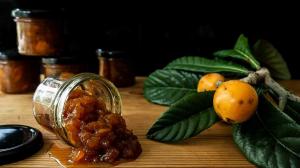We have a tall LOQUAT TREE in the shared garden of the property-owners. The LOQUAT isn’t a well-known fruit and it is still often called a Japanese MEDLAR or PLUM, even though originally from China and Central Asia. The other European names for this fruit that you might recognize are NISPERO, NESPOLO, PIPA, MISPEL, MOUSMOULIA, BIBACE or NEFLE. It is fleshy, sweet and slightly acidic and tastes like a combination of peach, mango and citrus.
This tree appeared in Europe, the Middle East and Northern Africa in the 15th and 16th century, after being brought back from Asia. It can easily thrive in many backyards, gardens and even on the streets, throughout the warmer Mediterranean region and now can be found throughout the world. Our garden tree in colder Paris, only gives fruits every 2 years, so I try to take advantage of that and either make preserves (with less sugar) or jams (with more sugar) which works well since the fruits have a high pectin content.
It isn’t well known because it isn’t used as industrially as other fruits are. The flesh is used for jams and jellies and preserves. The seeds and kernels of the loquat, just like apricots kernels/nuts and bitter almonds, are used to make liquors, similar to amaretto. Bitter seeds are often suspected and feared for their potential toxicity. The European varieties of loquats have very low levels of toxins so they’re the safest. Heating them or simply roasting them decreases the bitterness and makes them edible, but you’ll only eat a few anyways, which is normal for bitter-tasting things They say that what doesn’t kill you makes you stronger. You can oven-roast and taste a few if you like but I didn’t add them to the preserves since I was giving a few jars to friends with kids and I didn’t want to mix them up or cause trouble.
You can make jams, which are usually half fruit and half sugar, or preserves that are less sweet and less dense than jams with 2/3 fruit and 1/3 sugar (or even less). They will thicken up as they cool down after cooking. My cover photo of the preserves looks watery because the photo was taken when the preserves were still quite hot !
Of course it’s tasty, otherwise why would I share this with all of you and the cardamom pods and bay leaf are a nice fresher and greener addition but you can use vanilla for a warmer sensation.
We also have a yellow KIWI tree/vine in our garden . . . :)









